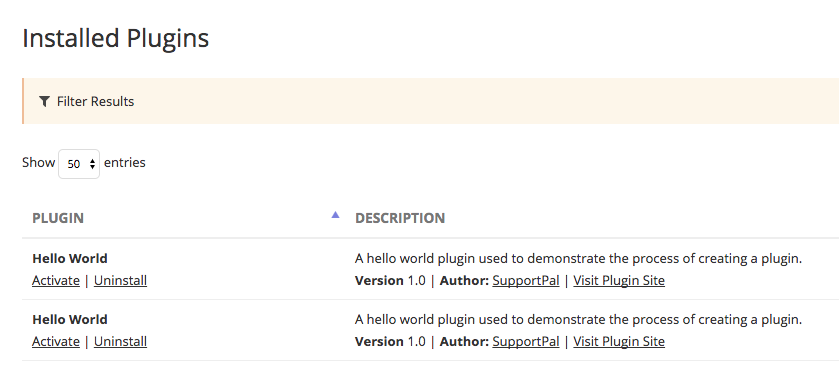Plugin Development: Getting Started
Learn about what a plugin is, a plugin's basic structure and how to initially configure your own plugin.
What is a Plugin?
A plugin lets you add an individual bit of functionality or allows modifying data that is being handled by the system. Some examples of what you can do with plugins:
- Sending notifications to your Slack channel on ticket actions.
- Connecting to your billing system and displaying the user's products in the ticket view.
- Adding useful actions based on the submitted ticket custom field values.
All plugins belong within the /app/Plugins directory, each with its own directory that is named the same as the plugin name. Each plugin usually has the following basic file structure, with more details about some of the folders and their files later in this guide.
| File/Folder | Description |
|---|---|
config.php |
The configuration file for the plugin, where you set the name, version and other important details about the plugin that shows in the operator panel when activating the plugin for the first time. |
composer.json |
If you need to use any libraries in your plugin, you can install them using composer by declaring them in this file and running composer install in the plugin folder. The plugin initialisation code checks for the presence of vendor/autoload.php to automatically load any dependencies that you use. |
Controllers/ |
Controllers are where the main logic of your plugin is stored. Your plugin must have a class with the same name as the plugin in this folder, which is used to initialise the plugin. |
Lang/ |
If you wish to support multiple languages, you can store the translations in this folder. |
Listeners/ |
Any event listeners, template hooks and view composers should be stored in this folder. |
Requests/ |
Form request validation can be stored in this folder, used to validate data that is sent in a request before it is made available to the controller action. |
Routes/ |
Any additional routes are declared in files in this folder, for example a GET and POST route for the plugin settings page. |
Views/ |
Any templates used by the plugin are stored in this folder, for example for displaying the plugin settings page. |
vendor/ |
Any libraries installed via composer will be placed in this folder. |
Choosing a Name
Each plugin must have its own unique name for it to function alongside the other plugins active in the system. The name you use must have a capitalised letter for each word with no spaces, such as HelloWorld and ThisIsMyPlugin.
Starting with the HelloWorld Plugin
We recommend to use the included HelloWorld plugin as the starting point of your own plugin. Copy the folder and rename the copy to your chosen plugin name. The file Controllers/HelloWorld.php must also be renamed to the plugin name, and the references to HelloWorld inside this file should also be changed to the plugin name too. Once you've done this, you will be able to see the plugin in the operator panel but it will still have the name Hello World for now, this can be changed by editing the configuration options as below.
Configuration Options
The following configuration options are available in config.php.
| Setting | Description |
|---|---|
| Name | Set the user friendly name for the plugin. For example, for the HelloWorld plugin, this is set to "Hello World". |
| Plugin URI | If you are developing this plugin to be distributed to other users, you may include a specific link about the plugin from your website. This is particularly useful if you will have a specific page and/or documentation on your website. |
| Description | A quick description of what the plugin will achieve, is shown to users in the plugin grid when they are going to activate/manage their plugins. |
| Version | Set the version of the plugin, such as '1.2.0'. |
| Author | Include your or your company's name here. |
| Author URI | Include a link to your website here. |
After setting the configuration options, your plugin will show properly in the grid.
Debugging Errors
To help with debugging while developing your plugin, we recommend the following settings. In the operator panel, please go to Settings and click the Debug tab:
- Enable the Debug Mode option. This will display errors in the browser in a user friendly format.
- Disable the Send Diagnostic Data option. This will mean it doesn't report errors that are generated by your plugin to our error reporting system.

